BIOSAFETY CABINETS I and II
What is a biological safety cabinet?
There are numerous risk factors involved in the daily basis routine in any kind of laboratory. Therefore, the lab’s personnel need to be on constant watch and care of every activity that is done in the laboratory. Risk factors can be high voltages, high and low pressures and temperatures, corrosive and toxic chemicals, and biohazards including infective organisms and their toxins. That is why Biosafety Cabinets are fundamental devices inside the laboratory.
Biological safety cabinets (BSCs, also called biological safety cabinets, biological hood or microbiological safety cabinets) are designed to protect the operator, the laboratory environment and work materials from potentially infectious agents, such as primary cultures, stocks and diagnostic specimens. There are three types of Safety Cabinets, basically because of the addition of a high-efficiency particulate air (HEPA) filter to the exhaust system, removing harmful bacteria and viruses.
Class I Biosafety Cabinets
Class I Biosafety Cabinets provide personnel and environmental protection inside the laboratory. They have the most basic and rudimentary design among all of the biological safety cabinetry that is available in the market. The way they work is when a stream of inward air moves into the cabinet with aerosols during microbiological manipulations, then passes through a filtration system trapping all airborne particles and contaminants. The process finishes when the decontaminated air is exhausted from the cabinet. Its simple design allows Class I widely use throughout the world. Besides the personal and environmental protection, it can also be used for work with radionuclides and volatile toxic chemicals. However, the room air is not unsterilized and it comes to the work surface through the front opening so it does not provide a reliable product protection.
Class II Biosafety Cabinets
The pass of unsterilized air over the work surface is not satisfactory in the case of using cell and tissue cultures for the propagation of viruses. Class II cabinets protect the samples and the environment since makeup air is also HEPA-filtered. The basic operation of this BSC is related to the use of fans mounted in the cabinet to draw directional airflow around a user and into the air grille. The air passes underneath the work surface and back to the top of the cabinet, passing throw the HEPA filters. These filter sterilized the air which is also blown downward over products to prevent contamination. Air is also exhausted through HEPA filter and the air could be (depending on the type) either back into the laboratory or pulled by an exhaust fan, through ductwork, expelled from the building.
There are five types defined by NSF International Standards: Type A1, Type A2, Type B1, Type B2, and Type C1. The differences between Class II Biosafety Cabinet types rely on the air intake velocity through the front opening; the amount of air recirculated over the work surface and exhausted from the cabinet; and the exhaust system (if the air is exhausted to the room or outside).
To see our Biosafety Security cabinets, follow this link HERE



